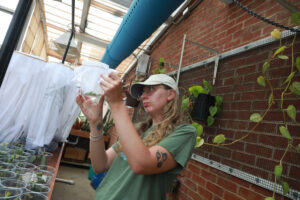
When red milkweed beetles engage in combat, they don’t just fight with their bodies – they communicate through vibrations that travel across the plant. This summer, University of Mary Washington students are investigating whether these fighting vibrations might actually prevent battles rather than provoke them, challenging assumptions about insect behavior.
It’s the kind of hands-on discovery that defines UMW’s Irene Piscopo Rodgers ’59 Summer Science Institute (SSI), now in its 26th year. The 10-week experience pairs undergraduate researchers with faculty mentors for intensive research projects, from insect communication and environmental contamination to complex computer algorithms. This year’s projects showcase an interdisciplinary approach and real-world applications, with 30 students tackling scientific questions across seven STEM disciplines – biology, chemistry, computer science, earth and environmental sciences, geography, mathematics and physics.
“What surprised me most was how collaborative research really is,” said senior Autumn Pembelton, a conservation biology major working with Assistant Professor of Biology Lauren Cirino on the milkweed beetle project. “I’ve learned that other people are absolutely crucial to making a project successful,” she said of the work, which employed a laser vibrometer and some support from Assistant Professor of Physics Varun Makhija on getting the experimental design set up.
The institute culminates with a public symposium on Wednesday, July 23, when students present their findings through oral presentations and posters from 9 a.m. to 5 p.m. in the Cedric Rucker University Center’s Chandler Ballroom. Winners in both presentation categories will receive scholarship awards supported by 1961 Mary Washington alumna Dr. Jerri Barden Perkins.
Originally launched in 1999 with support from a DuPont grant, the program has evolved significantly since Professor of Chemistry Ray Scott first organized seven research teams. Over its quarter-century history, the program has incorporated an array of new disciplines and given over 500 students the chance to conduct dynamic undergraduate research on campus and in the field.
In 2024, the Institute was renamed to honor Irene Piscopo Rodgers ’59, whose gift of more than $30 million to the University ensured continued growth in undergraduate STEM research opportunities. SSI students receive full funding, including room, board and stipends, allowing them to focus entirely on their studies.
Juniors Marina Klein, a chemistry major, and Emily Hart, an applied mathematics and statistics double major, are tackling the tricky task of detecting explosive compounds in environmental samples. They often work in dimmed lighting or walk-in fridges to prevent degradation of the explosives they’re studying.
“We’ve learned one method can’t be used for all the explosives; we need to use at least two methods in tandem to quantify everything,” said their mentor, Assistant Professor of Chemistry Sarah Smith ’12, an SSI participant herself as a UMW undergrad. Her students are collaborating with another research team led by Associate Professor of Earth and Environmental Sciences Tyler Frankel.
Meanwhile, Assistant Professor of Computer Science Evan Coleman’s team is tackling computational challenges. Using image processing techniques in machine learning, senior Kassandra Williams, a computer science major and cyber security minor, is working to accelerate large-scale linear algebra problems – the mathematical backbone of applications like computational fluid dynamics and weather modeling.
In addition to the beetle study, Cirino’s biology students are exploring resource allocation in leaf-footed cactus bugs, investigating how insects balance survival and reproduction when their immune systems are compromised. The research has already required adjustment – when one injury method proved too harsh for juvenile insects, senior Lillie Burbulis, a biology major and climate science minor, pivoted to a gentler approach that’s showing more promising results.
“As someone who learns better by doing hands-on projects, SSI has solidified my love and understanding of science,” Burbulis said. “I know that research is a path I want to continue to pursue because of this program.”
Associate Professor of Chemistry Randall Reif, who directs SSI, said he appreciates its capacity to provide participants like Burbulis the opportunity to dedicate themselves to research for a full 10 weeks. “It represents a chance for students to learn about topics that aren’t always taught in the classroom,” he said. “They discover what scientific research is like in the real world.”
The Symposium on Wednesday, July 23 is free and open to the public from 9 a.m. to 5 p.m. in the Cedric Rucker University Center’s Chandler Ballroom.
Symposium Award Winners
The Summer Science Institute Symposium concluded July 23 with scholarship awards for outstanding student presentations, supported by 1961 alumna Dr. Jerri Barden Perkins.
Poster presentation winners
• First place: Joey Gasink, Earth and Environmental Science: Applying Climate Change Models to Improve Traditional Exposure Testing Using Adult and Embryonic Seminole Ramshorn (Planorbella duryi) Snails
Faculty advisor: Dr. Tyler Frankel
• Second place: Summer Orledge, Earth and Environmental Science: Assessing the Presence and Concentration of Trace Metal Contamination Around an Unlined Landfill in King William County, Va.
Faculty advisor: Dr. Tyler Frankel
Oral presentation winners
• First place: Lily Gruss, Chemistry: Improved Synthesis of the Metabolites of Di(2-ethylhexyl) Phthalate
Faculty advisor: Dr. Davis Oldham
• Second place: Eric Torres, Earth and Environmental Science: Spatial, Temporal, and Ecological Impact Analysis of Trace Metal Enrichment in a Central Appalachian Coal Mining Watershed
Faculty advisor: Dr. Ben Odhiambo Kisila



















Impressive! thanks for sharing
Jerri
Jerri Barden Perkins,MD